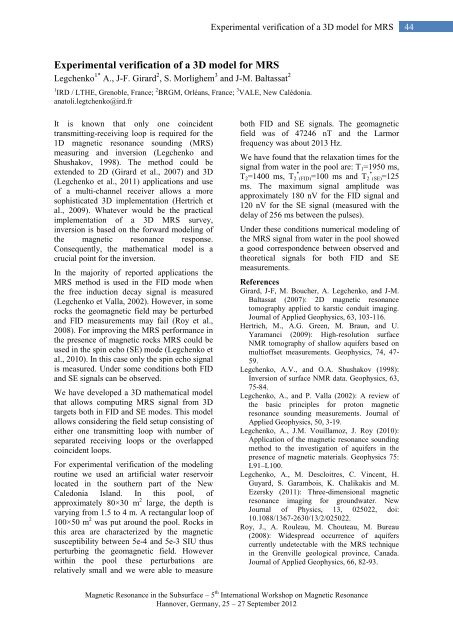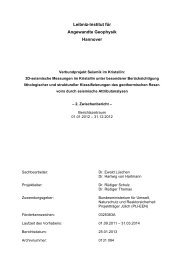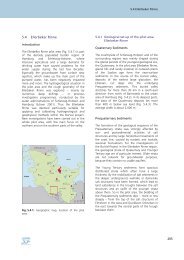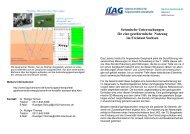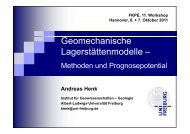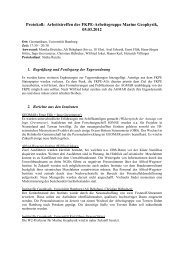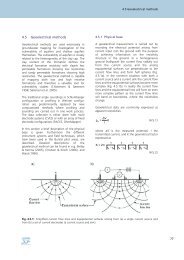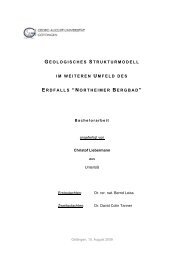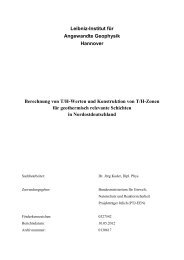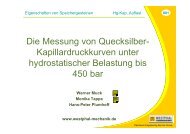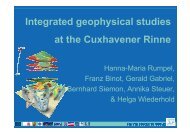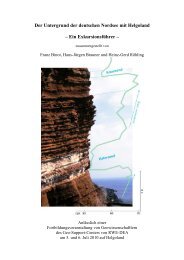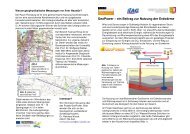Magnetic Resonance in the Subsurface – 5th International ... - LIAG
Magnetic Resonance in the Subsurface – 5th International ... - LIAG
Magnetic Resonance in the Subsurface – 5th International ... - LIAG
Create successful ePaper yourself
Turn your PDF publications into a flip-book with our unique Google optimized e-Paper software.
Experimental verification of a 3D model for MRS<br />
Legchenko 1* A., J-F. Girard 2 , S. Morlighem 3 and J-M. Baltassat 2<br />
1 IRD / LTHE, Grenoble, France; 2 BRGM, Orléans, France; 3 VALE, New Calédonia.<br />
anatoli.legtchenko@ird.fr<br />
It is known that only one co<strong>in</strong>cident<br />
transmitt<strong>in</strong>g-receiv<strong>in</strong>g loop is required for <strong>the</strong><br />
1D magnetic resonance sound<strong>in</strong>g (MRS)<br />
measur<strong>in</strong>g and <strong>in</strong>version (Legchenko and<br />
Shushakov, 1998). The method could be<br />
extended to 2D (Girard et al., 2007) and 3D<br />
(Legchenko et al., 2011) applications and use<br />
of a multi-channel receiver allows a more<br />
sophisticated 3D implementation (Hertrich et<br />
al., 2009). Whatever would be <strong>the</strong> practical<br />
implementation of a 3D MRS survey,<br />
<strong>in</strong>version is based on <strong>the</strong> forward model<strong>in</strong>g of<br />
<strong>the</strong> magnetic resonance response.<br />
Consequently, <strong>the</strong> ma<strong>the</strong>matical model is a<br />
crucial po<strong>in</strong>t for <strong>the</strong> <strong>in</strong>version.<br />
In <strong>the</strong> majority of reported applications <strong>the</strong><br />
MRS method is used <strong>in</strong> <strong>the</strong> FID mode when<br />
<strong>the</strong> free <strong>in</strong>duction decay signal is measured<br />
(Legchenko et Valla, 2002). However, <strong>in</strong> some<br />
rocks <strong>the</strong> geomagnetic field may be perturbed<br />
and FID measurements may fail (Roy et al.,<br />
2008). For improv<strong>in</strong>g <strong>the</strong> MRS performance <strong>in</strong><br />
<strong>the</strong> presence of magnetic rocks MRS could be<br />
used <strong>in</strong> <strong>the</strong> sp<strong>in</strong> echo (SE) mode (Legchenko et<br />
al., 2010). In this case only <strong>the</strong> sp<strong>in</strong> echo signal<br />
is measured. Under some conditions both FID<br />
and SE signals can be observed.<br />
We have developed a 3D ma<strong>the</strong>matical model<br />
that allows comput<strong>in</strong>g MRS signal from 3D<br />
targets both <strong>in</strong> FID and SE modes. This model<br />
allows consider<strong>in</strong>g <strong>the</strong> field setup consist<strong>in</strong>g of<br />
ei<strong>the</strong>r one transmitt<strong>in</strong>g loop with number of<br />
separated receiv<strong>in</strong>g loops or <strong>the</strong> overlapped<br />
co<strong>in</strong>cident loops.<br />
For experimental verification of <strong>the</strong> model<strong>in</strong>g<br />
rout<strong>in</strong>e we used an artificial water reservoir<br />
located <strong>in</strong> <strong>the</strong> sou<strong>the</strong>rn part of <strong>the</strong> New<br />
Caledonia Island. In this pool, of<br />
approximately 80×30 m 2 large, <strong>the</strong> depth is<br />
vary<strong>in</strong>g from 1.5 to 4 m. A rectangular loop of<br />
100×50 m 2 was put around <strong>the</strong> pool. Rocks <strong>in</strong><br />
this area are characterized by <strong>the</strong> magnetic<br />
susceptibility between 5e-4 and 5e-3 SIU thus<br />
perturb<strong>in</strong>g <strong>the</strong> geomagnetic field. However<br />
with<strong>in</strong> <strong>the</strong> pool <strong>the</strong>se perturbations are<br />
relatively small and we were able to measure<br />
Experimental verification of a 3D model for MRS 44<br />
both FID and SE signals. The geomagnetic<br />
field was of 47246 nT and <strong>the</strong> Larmor<br />
frequency was about 2013 Hz.<br />
We have found that <strong>the</strong> relaxation times for <strong>the</strong><br />
signal from water <strong>in</strong> <strong>the</strong> pool are: T1=1950 ms,<br />
T2=1400 ms, T2 * (FID)=100 ms and T2 * (SE)=125<br />
ms. The maximum signal amplitude was<br />
approximately 180 nV for <strong>the</strong> FID signal and<br />
120 nV for <strong>the</strong> SE signal (measured with <strong>the</strong><br />
delay of 256 ms between <strong>the</strong> pulses).<br />
Under <strong>the</strong>se conditions numerical model<strong>in</strong>g of<br />
<strong>the</strong> MRS signal from water <strong>in</strong> <strong>the</strong> pool showed<br />
a good correspondence between observed and<br />
<strong>the</strong>oretical signals for both FID and SE<br />
measurements.<br />
References<br />
Girard, J-F, M. Boucher, A. Legchenko, and J-M.<br />
Baltassat (2007): 2D magnetic resonance<br />
tomography applied to karstic conduit imag<strong>in</strong>g.<br />
Journal of Applied Geophysics, 63, 103-116.<br />
Hertrich, M., A.G. Green, M. Braun, and U.<br />
Yaramanci (2009): High-resolution surface<br />
NMR tomography of shallow aquifers based on<br />
multioffset measurements. Geophysics, 74, 47-<br />
59.<br />
Legchenko, A.V., and O.A. Shushakov (1998):<br />
Inversion of surface NMR data. Geophysics, 63,<br />
75-84.<br />
Legchenko, A., and P. Valla (2002): A review of<br />
<strong>the</strong> basic pr<strong>in</strong>ciples for proton magnetic<br />
resonance sound<strong>in</strong>g measurements. Journal of<br />
Applied Geophysics, 50, 3-19.<br />
Legchenko, A., J.M. Vouillamoz, J. Roy (2010):<br />
Application of <strong>the</strong> magnetic resonance sound<strong>in</strong>g<br />
method to <strong>the</strong> <strong>in</strong>vestigation of aquifers <strong>in</strong> <strong>the</strong><br />
presence of magnetic materials. Geophysics 75:<br />
L91<strong>–</strong>L100.<br />
Legchenko, A., M. Descloitres, C. V<strong>in</strong>cent, H.<br />
Guyard, S. Garambois, K. Chalikakis and M.<br />
Ezersky (2011): Three-dimensional magnetic<br />
resonance imag<strong>in</strong>g for groundwater. New<br />
Journal of Physics, 13, 025022, doi:<br />
10.1088/1367-2630/13/2/025022.<br />
Roy, J., A. Rouleau, M. Chouteau, M. Bureau<br />
(2008): Widespread occurrence of aquifers<br />
currently undetectable with <strong>the</strong> MRS technique<br />
<strong>in</strong> <strong>the</strong> Grenville geological prov<strong>in</strong>ce, Canada.<br />
Journal of Applied Geophysics, 66, 82-93.<br />
<strong>Magnetic</strong> <strong>Resonance</strong> <strong>in</strong> <strong>the</strong> <strong>Subsurface</strong> <strong>–</strong> 5 th <strong>International</strong> Workshop on <strong>Magnetic</strong> <strong>Resonance</strong><br />
Hannover, Germany, 25 <strong>–</strong> 27 September 2012


